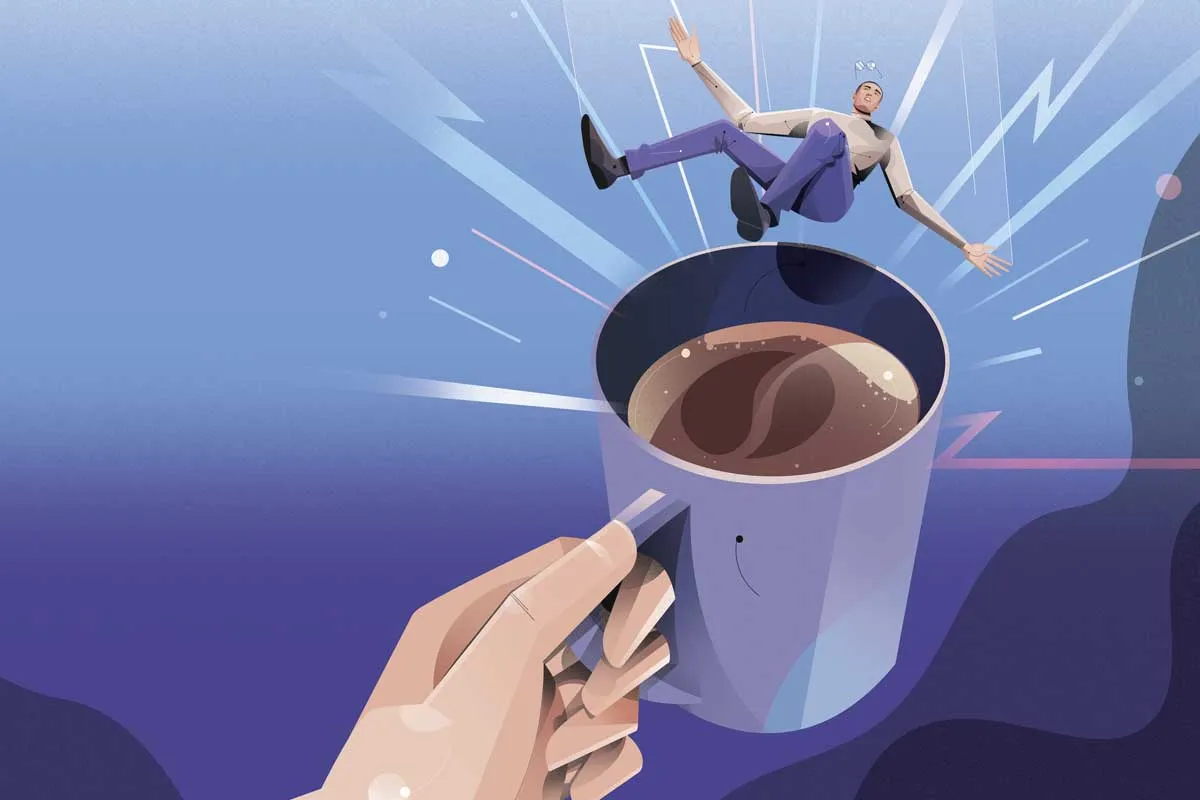Anxiety can be, at times, truly debilitating, making it hard to go about your day. However, feelings of unease, worry and fear – whether mild or more severe – can be dealt with. In the moment of an anxiety attack or any feelings of uneasiness, there are ways to step back and bring yourself back to a more comfortable feeling.
Equally, for those who deal with anxiety on a constant basis, there are longer-term ways to address anxiety. Here are eight, science-backed methods, to lessen feelings of anxiety, both in the long- and short-term.
Short-term tools to lessen your anxiety
1. Distance yourself from your anxieties
Bouts of anxiety often begin with catastrophic thinking about an upcoming event.
You start imagining the myriad ways you’ll make a fool of yourself on afirstdate; you picture yourself tongue-tiedduringan interview; or you conjure vivid images of the various ways that an aeroplane can malfunction.
One way to dampen anxiety is to calm these racing thoughts. Don’t do this with brute mental force – simply trying to stifle the thoughts and push them out of your mind is unlikely to work and could even backfire.
Instead, try to create some distance from the thoughts, to help you realise that thoughts can be wrong and are not self-fulfilling.
Say to yourself: “I am having the thought that… I am going to embarrass myself on this first date [obviously replace this with your own anxious thoughts]”.
Having created this distance, calmly weigh the evidence for why you might make a fool or yourself, and then spend as much effort listing the ways that you might not. Also remind yourself of times in the past when you’ve coped well.
Read more:
2. Ground yourself

If your mind is racing with catastrophic thoughts about what’s going to happen, your body responds in kind: the sympathetic nervous system kicks in, bracing you for a threat – your breathing becomes fast and shallow,and adrenaline races to your muscles, which can cause you to tremble and feel faint.
A great way to dampen this reaction is to practise exercises that activate the parasympathetic nervous system, which has opposite effects on the bodyto thesympatheticnervoussystem, such as lowering your heart rate and blood pressure,and slowing your breathing.
Oneexerciseis called ‘grounding’, which helpsyou connect with the present moment and the environment around you, rather than being consumed by fears about the future.
One popularway to do itinvolves pausing and naming five things you can see; naming four things you can feel; three things you can hear; two things you can smell; and one thing you can taste.
Another technique that activatesthe soothing parasympathetic nervous systemis tostand with your feet a comfortable distance apart and lean forwards as if you’re going to touch your toes – it doesn’t matter how far you can actually reach – and then just hang there for a minute or so (you can also do this in a seated position by leaning forwards and allowing your head to hang comfortably between your legs).
The idea behind this exercise is that it sends a strong signal to your body that all is safe, and you can relax.
3. Regulate your breathing
Another way to calm your body down, promote parasympathetic nervous system activity and break the anxiety cycle (in which your body’s fear reaction to your thoughts makes you even more anxious) is to practise a controlled breathing exercise.
There are many different exercises you can try, but one of the simpler and more effectiveexamplesis known as ‘box breathing’ or ‘square breathing’, so called because you breath in, pause andthenbreathe out each for the same amount of time.
To do it, sit somewhere comfortable and focus on your breath.
- Inhale for four seconds
- Pause for four seconds
- Exhale for four seconds.
- Try to repeat this for at least30seconds and continue for as long as you feel comfortable orfor as long as you need
The idea is that this will help to get your breathing rate and depth back under control, which is an effective way to calm the entire body.
4. Plan a ‘worry window’
If you find that your worries keep coming back, even after you’ve calmed your mind and body, it can be very unsettling and give you the sense that you’re stuck in a loop.
You might even come to form unhelpful beliefs, such as that you need to engage in worry to try to ‘solve’ a dilemma or to prevent a bad thing from happening – these are known as ‘meta-cognitions’ because they’re your beliefs about your thoughts.
However, unless you’re forming genuine solutions or constructive plans in your mind, then churning the same worries around and around is futile, like a car’s wheel spinning in the mud. Trying to banish these worries from your mind is unlikely to work.
A better approach is to plan a ‘worry window’ – a set period of time, about half an hour or so (ideally not too close to bedtime) when you’ll allow your mind to give vent to its worries.
The rest of the time, whenever your worrisome thoughts surface, you can remind yourself that you’ll be turning your attention to them later.
This can be an effective way to break out of a perpetual worry loop and allow you to get on with your life.
Read more:
Long-term tools to lessen your anxiety
1. Confront your fears

It’s natural to want to avoid the situations that make you anxious but,in the long-term,this is only likely to fuel your anxiety.
When you avoid anxiety-provoking situations, not only do you risk missing out on opportunities in life, but you never get to ‘reality-check’ your worst fears – for instance, going on a date without it being a disaster, or flying on a plane and finding that it stays in the air.
Unconfronted fears can grow and fester, assuming an out-of-proportion aura of doom.
In contrast, when you face your fears and find that the worst doesn’t happen, psychologists call it an ‘expectancy-violation’. You burst the baleful balloon.
By undermining your negative expectations like this, you gradually teach your brain to be less anxious. The technical term for confronting your fears and anxieties is ‘exposure’.
It’s a good idea to start gradually. Choose a situation or challenge that you only find mildly anxiety-provoking and give it a go (using your emergency tool-kit before, during and after as appropriate).
If real-life exposure is too daunting – you can even try doing it in your imagination.
2. Exercise regularly
Building opportunities for physical exercise into your lifestyle isn’t only good for your body, it’s good for your mind too.
Studies have shown that exercise can boost mood and stave off depression. People who are more physically active also tend to show benefits to their personality traits years down the line, including keeping their neuroticism in check.
Other research shows that regular exercise can help prevent the risk of developing an anxiety disorder.
There are many reasons why exercise has these benefits, including distraction, camaraderie and improvements in physical health – which can break the known links between poor health and anxiety.
Yet another reason why exercise – especially vigorous exercise – is a great tool for beating anxiety is that it can get you used to the kind of physical sensations that fuel anxiety, such as a racing heartbeat anda feeling ofbreathlessness.
If you’re used to these sensations in your weekly run or boxercise class, they won’t be so disconcerting the next time you have to give a speech or go for a job interview.
3. Go easy on the caffeine
Whether it’s in your morning espresso or an energy drink at the gym, caffeine might be such an integral part of your routine, that you don’t stop to think that it’s actually a psychostimulant – a drug that acts on the brain.
Specifically, caffeine acts to block the brain chemical adenosine, which usually serves to calm us down physiologically, such as by lowering our blood pressure and slowing our breathing.
This neural action is great in terms of making us feel more alert and hyped up but not welcome at all if you’re prone to anxiety.

So, one modest lifestyle change to make over the long term to reduce your anxiety levels is to consume less caffeine, remembering that it’s also present in chocolate and tea.
Indeed, if you’re an anxious person and you currently consume an excessive amount of caffeine, it’s feasible that it could contribute significantly to your problems – psychiatry even recognises ‘caffeine-induced anxiety disorder’ as a subtype of the formal diagnosis of ‘substance or medication-induced anxiety disorder’.
4. Consider your long-term relationship with anxiety
If you come to believe that being anxious is a fundamental, permanent part of who you are, then whenever you’re confronted by situations that make you feel uneasy or afraid, you’re more likely to succumb to the discomfort and withdraw as quickly as you can.
In contrast, if you can try to see anxiety as a temporary, fleeting state – one which is part of being human and can affect anyone at any time – then you’re more likely to find the motivation to ride out the discomfort and seek more constructive ways to deal with it.
Psychologists call this latter perspective a ‘growth mindset’ as opposed to a ‘fixed mindset’.
You might have heard these terms used in relation to intelligence and learning, but emerging research suggests the distinction also applies to how we think about our experiences of anxiety. So, consider your relationship to anxiety and remember it can be useful and it can be tamed.
Read more:
